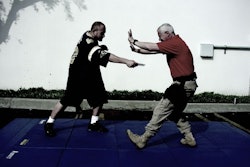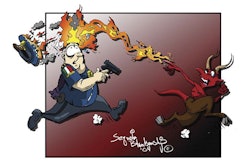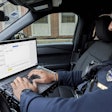On April 15 at about 7:30 p.m., Officer Stephen Gray of the Merced (Calif.) Police Department stopped a car on Glen Avenue. Official reports say that Gray then conducted a field interview with one of the passengers; the passenger resisted, a struggle ensued, and the passenger ran with Gray in pursuit. According to reports, the short foot chase ended when the passenger drew a handgun and shot the officer twice. Gray was pronounced dead later that evening at a local hospital.
Any officer who has ever had to run after a suspect knows that a foot chase is extremely hazardous. Running after a suspect can place you in a situation where you can be easily attacked, injured by accident, or even have a heart attack. Real life is not a movie, and the decision to hoof it after the bad guy should never be made lightly. It can be a life and death decision.
Consider these statistics from the Milwaukee Police Department. In the last 20 or so years, the Milwaukee PD has lost five officers in incidents that began as foot pursuits. Five out of 13 Milwaukee officers who have been killed in the line of duty since 1980 died following foot pursuits.
The message here should be stated in no uncertain terms: Never pursue a suspect on foot unless you absolutely have to.
Unfortunately, you sometimes have to do so. But you should know what you're getting into before you start sprinting after a suspect, and you should use every available and appropriate tactic to prevent a suspect from rabbiting.
The best way to end a foot pursuit is to prevent it from happening in the first place. Using the contact/ cover principle, you and your backup can position yourselves to stop a suspect from attempting to escape by cutting off escape routes. In addition, proper placement of officers makes it easy to perform a "quick snatch" technique that leads to rapid stabilization and keeps everyone safer by avoiding the "crash and burn" that often accompanies unexpected resistance.
It's also critical for you to understand that tactics are not just physical. One of the best tools you have to prevent a suspect from running is your voice. Good verbal communication tactics can help calm the suspect during an arrest or even an interview and prevent a foot pursuit.
Be Ready
The first rule of foot pursuits is to employ sound tactics to stop them before they start. The second is to be prepared to pursue a suspect because sometimes, despite your best efforts, he or she will run.
You have to be in good physical shape to become a cop, but once many of us have spent a few years on the job, we get pretty soft. This is why one of the primary hazards of a police foot chase is pulled muscles and other exertion-related injuries.
Years ago we worked with fellow officer Bob Willis to develop a program to train officers how to successfully conduct foot pursuits. It covered both physical preparedness and tactical awareness.
The first part of the program is what we call "Tactile Running." Essentially a physical training regimen, Tactile Running teaches officers how to prevent exertion injuries during a foot pursuit by focusing on flexibility, fitness, and environmental awareness.
Using the Tactile Running pursuit concept, you start out walking after the suspect, then you walk faster, speed up to a jog, and finally to a full sprint, if necessary. This foot pursuit strategy, added to a pre-work warm-up and several gentle stretches during your shift, will help you avoid the pulled muscles that often accompany a full sprint from a cold start, even if you've been sitting in a patrol car all shift.
Remember that one of the major factors in deciding whether to conduct a foot pursuit is your own personal fitness level. This is no laughing matter. The first indication for many people of a cardiac problem is sudden death from cardiac arrest.
Obstacle Course
OK. Let's assume you are a real athlete. You can run for miles on the academy track or on the local running club's cross-country course. That's great, we commend you on your fitness. But no matter how fit you are, it's important for you to remember that a foot pursuit is not an athletic event that takes place on a smooth track or maintained path.
This is why the Tactile Running concept includes training in how to run around obstacles. Common environmental hazards that officers encounter during foot pursuits include uneven terrain and low-light conditions, as well as swing sets, sandboxes, children's toys, garden tools, trash cans, and other items found in most residential neighborhoods and alleyways.
For the Tactile Foot Pursuit program, we set up a special running course in the Milwaukee County Sheriff's Office Gym. The gym consists of a two-level workout area and basketball courts with two staircases going up to an overhead running track and locker room areas. Once the doors were locked and secured and the lights turned down to a twilight level, the fun began. The officers ran laps around the entire facility. They ran along the gym floor, with all the weight benches, tables, chairs, volleyball nets, and associated junk left lying haphazard in their path, then up the stairs around the tracks doing a series of running to prone position to running exercises, into the locker rooms around the lockers and fixed benches, and down the stairs back to the gym floor.
(Trainers who want to duplicate this exercise can contact us through POLICE magazine's Web forum at www.policemag.com. We can provide you with detailed instructions on how to maximize officer safety during this strenuous training.)
Tactical Running
Once you have learned the sub-skill of staying physically safe from muscle injuries and obstacles during a foot pursuit, it's time to think tactically. To safely apprehend a suspect at the end of a foot pursuit you need to learn how to follow, not chase, learn how to know where the suspect is going to come out, and learn how and where to set up an ambush.
In our program, officers wore their duty belts and weapons and were allowed to plan how to deploy and use their weapons during actual foot pursuit drills. And they soon learned some hard lessons about when, where, and how a fleeing suspect can set you up. We then taught them how to avoid these traps and how to turn the tables on would-be assailants to successfully complete a foot pursuit.
It's very important that you understand the meaning of the word "successful" as it applies to police foot pursuits. A successful foot pursuit is not one where you necessarily catch the fleeing suspect. A successful foot pursuit means you get to go home safe and sound at the end of your shift and the job gets done. Remember, catching the bad guy is important, but there are no "acceptable casualties" in police work.[PAGEBREAK]
When to Pursue
Before participating in a foot pursuit, you have to decide whether the pursuit is worth the risk. You have to ask yourself, "Should I pursue?"
The answer to that very simple question is actually pretty complicated. To arrive at the decision of whether to pursue, you have to know the following information: Who is the subject? What help is available? When is the foot pursuit taking place? Where is the foot pursuit taking place? Why am I pursuing?
The answers to these questions are situational, so no magazine article or even training class can answer them for you. But before you go tearing down a dark alley in pursuit of a subject, make sure that you have asked these questions and answered them.
Break It Off
One of the most important lessons that an officer learns is that he or she can always disengage and/or escalate in order to take proper police action. This means that you can start and stop a foot pursuit for a whole series of valid justifiable reasons.
A now-veteran Milwaukee County Sheriff's Office sergeant told us the story of a traffic stop that turned into a foot pursuit. The pursuit ended when the heavy-breathing, but smiling, rookie deputy realized that he had the offender's driver's license, a positive ID, and the offender's new car in his possession. The deputy stopped chasing the suspect, caught his breath, walked back to his squad car, and called for a tow.
The lesson here is simple: Don't let the adrenaline pumping through your veins in the heat of a pursuit short-circuit your brain. If you can achieve the arrest later without a foot pursuit and the fleeing suspect does not represent an immediate threat to the people you serve, then call off the pursuit.
Area Containment
You can also avoid a pursuit by outsmarting the subject. For example, we like to teach new officers the theory of area containment as a means of making sure that a subject can run but can't hide.
It works like this. Using the contact/cover principle, a team of officers can position themselves at opposite corners of a house in order to establish visual surveillance of a building until other officers can be brought to the scene to search it tactically.
Area containment can also be used to seal off a full residential block. After a suspect flees into a residential area, a minimum of two squads can quickly position themselves at opposite corners of the block and establish visual control of that area. If the suspect doesn't violate the visual surveillance perimeter, the officers can wait for backup to arrive before searching for the suspect. If the suspect does cross the perimeter, the squads can leapfrog to keep the suspect "contained" until additional help arrives or the decision is made to call off the search.
Vehicle Pursuits and Foot Pursuits
You are in extreme danger when a vehicle pursuit turns into a foot pursuit. Don't let your initial decision to pursue a vehicle automatically turn into a decision to pursue on foot when a suspect bails out of a vehicle. This is a totally new decision based on a totally new set of facts.
Remember that the vehicle that is stopped is itself evidence. It can also have evidence in it, which can include weapons. During a foot pursuit a suspect can circle around and return to his or her vehicle and drive away or retrieve weapons and/or evidence. In addition, your squad car, its equipment, and the weapons left behind are subject to theft. Don't let adrenalin rule your good tactical sense.
Subject Control on the Run
How to establish physical control of a suspect who is fleeing from an officer on foot has always been the subject of debate. Defensive tactics will always be a matter of opinion but there are practical issues that must be addressed.
First of all, don't follow too closely, directly behind the fleeing suspect. If the suspect stops suddenly, you will crash right into him. If you can't establish an escort position to decentralize the subject, you may need to "check" him to stop his run and then move in for physical control or draw your handgun and order him into your department's handcuffing position.
If the suspect suddenly turns and assaults you, you may not be able to respond in time to prevent the initial assault. Be ready for a sudden change in the suspect's behavior from flight to fight.
We teach our students to remember Coach Bob Lindsey's When/Then principle. For example, when the fleeing suspect turns and assaults me, then I will ... Be sure you know the answer.
Drawn Handgun Subject Control
The final issue that needs to be discussed is the decision to chase a suspect with your firearm drawn. There are many reasons for not running with your handgun drawn: the increased risk of unintentional discharge, the danger of falling, dropping your gun, and losing your gun during a scuffle, just to name a few.
Running with a handgun is not easy nor is it advised. It's dangerous, but, of course, so is facing an armed assailant with your firearm holstered. If you have to chase with your firearm drawn, remember the number one rule of foot pursuits: if you get hurt, you fail. If you need your firearm drawn and can't pursue safely, which includes safe gun handling, you probably should back off.
And be aware that although there are many hazards to running after someone with your gun drawn, you are in the most danger when you actually catch up to your target. When you are toe to toe with the suspect with your firearm drawn, you must control the suspect and maintain control of your sidearm.
This presents you with two primary problems. One is the danger of being disarmed. The other is the possible unintentional discharge of your weapon due to a "sympathetic reaction" when you grab the suspect with your non-gun hand.
One solution is to transition your firearm to your non-gun hand, reducing the chance of an unintentional discharge while presenting your strong side and favored striking side, for subject control. This tactic will also help prevent you from using your gun as an impact weapon, possibly causing severe damage to the subject's head. Striking a subject in the head with a firearm could lead to public relations and courtroom problems. In addition, by transitioning your sidearm to your non-gun hand and controlling the suspect with your gun hand, you make it considerably more difficult for him or her to grab your weapon.
Remember that if we don't learn from history, we are doomed to repeat it. The Milwaukee Police Department and other departments throughout the country have learned some tragic lessons over the years. To prevent such tragedies, officers have developed tactics and training to minimize the risks. Use these tactics and training to your advantage.
Gary Klugiewicz is a retired captain with the Milwaukee County Sheriff's Office. He is nationally known as a law enforcement use-of-force expert who specializes in high-level control tactics and is the director of training for the Fox Valley Technical College Tactical Training Division located in Appleton, Wis.
James Smith is a detective with the Milwaukee Police Department. He gained national recognition as the lead instructor for the Calibre Press's Realistic Assailant Control Training Program and as the developer of the Tactile Running and Tactical Running Training Programs.













